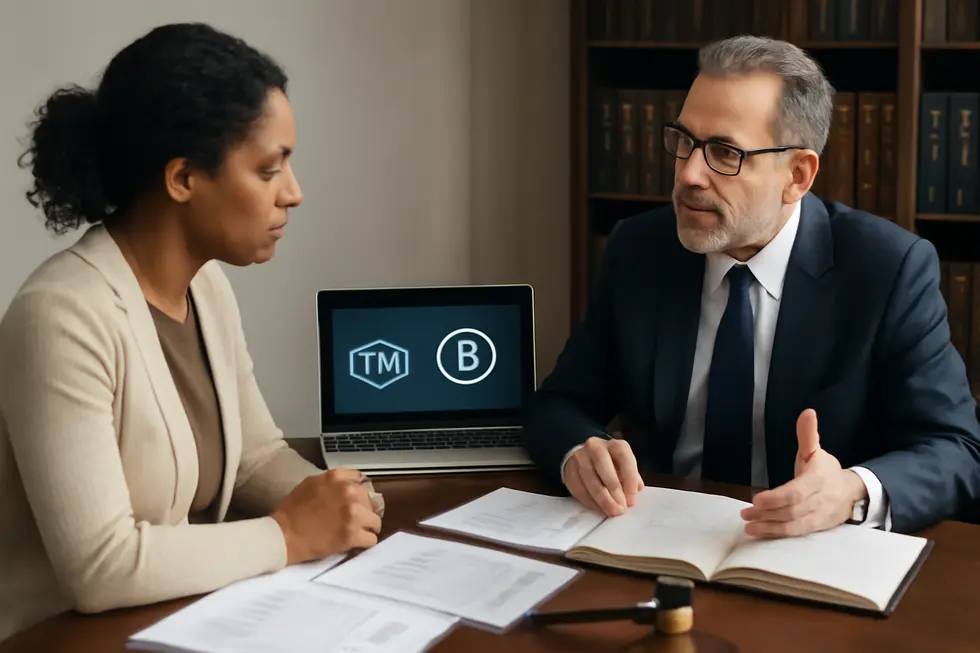Introduction
Choosing whether to trademark your business name and logo is a critical decision that can determine the future security and growth of your brand. While not legally required, trademark registration offers significant advantages by safeguarding your identity from unauthorized use and ensuring clear ownership. This exploration will first clarify the legal protections trademarks provide, helping you understand their role in preventing infringement disputes. Next, it outlines the step-by-step process and highlights the strategic importance of filing for trademark registration. Following that, the economic and competitive benefits reveal how a registered trademark can enhance your market position and business valuation. Finally, the discussion addresses digital and brand security considerations, emphasizing why protecting your brand in online spaces is now indispensable. Together, these chapters provide a comprehensive understanding for business owners weighing the need to trademark their identity.
Tables of Contents
Chapter 1: Understanding Legal Protection when you ask do i need to trademark my business name and logo
- Why Securing Legal Rights Through Trademarking Is Essential for Your Business Identity
- Navigating the Trademark Registration Journey: Legal Steps to Secure Your Business Name and Logo
- Clarifying How Trademark Protection Stands Apart from Copyright and Patent Rights
Chapter 2: The Process and Importance of Filing do i need to trademark my business name and logo
- Trademarking Your Business Name and Logo: Essential Legal Foundations and Step-by-Step Process
- Mastering Trademark Registration: Essential Steps to Secure Your Business Name and Logo
- Strategic Advantages and Practical Considerations for Trademarking Your Business Name and Logo
Chapter 3: Economic and Competitive Benefits of Do I Need to Trademark My Business Name and Logo
- Unlocking Financial Growth: How Trademarking Boosts Your Brand’s Economic Strength
- How Trademark Registration Secures Market Exclusivity and Strengthens Legal Defense
- How Technology, Global Politics, and Society Amplify the Value of Trademark Protection
Chapter 4: Digital and Brand Security Considerations of do i need to trademark my business name and logo
- Securing Legal Rights and Brand Identity: Why Trademarking Your Business Name and Logo Matters
- Strengthening Brand Defense with Trademark Registration and Digital Vigilance
- Unlocking Economic Growth and Brand Security Through Trademark Registration
Chapter 1: Understanding Legal Protection when you ask do i need to trademark my business name and logo

1. Why Securing Legal Rights Through Trademarking Is Essential for Your Business Identity
Trademarking your business name and logo grants essential legal rights that protect your brand identity from competitors. Unlike common law rights, which are limited geographically and can be difficult to enforce, registered trademarks provide nationwide exclusive rights, allowing you to prevent others from using confusingly similar marks in your industry. This legal exclusivity helps avoid consumer confusion and maintains your business’s reputation, which is critical for building customer trust.
Beyond protection, trademarks elevate your business’s credibility and appeal to investors by signaling a secure and distinctive brand. These protections extend beyond names and logos to include slogans, colors, and other unique brand elements that identify your products or services. However, not all marks qualify—generic or purely descriptive terms without distinctiveness may be ineligible.
Early registration is a strategic move to avoid conflicts with existing trademarks and deter copycats as your business grows. For businesses aiming to expand beyond local markets, securing a trademark is a key step in safeguarding long-term brand value. While small local businesses may initially rely on common law rights, registered trademarks simplify legal enforcement and provide stronger deterrents against infringement.
For a deeper understanding of protecting your business identity through trademarks, exploring resources like the insights on trademark protection for business name and logo can offer valuable guidance. External expert guides also help clarify the timing and process of trademark registration to align with your business goals.
2. Navigating the Trademark Registration Journey: Legal Steps to Secure Your Business Name and Logo
Securing trademark registration for your business name and logo involves a deliberate legal process designed to safeguard your brand identity. It begins with conducting a comprehensive trademark search to confirm that no existing marks closely resemble yours, reducing the risk of application denial or future disputes. After confirming uniqueness, you prepare and submit an application to the U.S. Patent and Trademark Office (USPTO). This application must accurately depict your business name or logo, specify the goods or services it represents, and categorize them under appropriate trademark classes.
Once submitted, a USPTO examiner reviews your application to ensure your mark is distinctive, not confusingly similar to others, and meets legal requirements. If the application passes this review, it enters a publication phase where third parties can oppose registration if they claim infringement upon their rights. Without objections or successful oppositions, your trademark proceeds to registration, granting you exclusive nationwide rights and the right to use the ® symbol.
Maintaining trademark protection requires timely renewals—typically between the fifth and sixth year and every ten years thereafter—and proof of ongoing use in commerce. Unlike copyright, which may protect artistic logos but cannot stop others from using similar marks, trademark registration secures exclusive brand use related to specific goods/services within geographic scope. Navigating this process often benefits from legal expertise to avoid common pitfalls such as weak marks, improper searches, or neglecting renewals, ensuring your brand remains legally protected and commercially strong.
For a detailed guide on protecting your business name and logo through trademark registration, visit trademark protection business name logo.
3. Clarifying How Trademark Protection Stands Apart from Copyright and Patent Rights
Trademark protection plays a crucial role in safeguarding the unique identifiers of your business, such as its name, logo, and slogans, creating a clear distinction from the protections offered by copyrights and patents. While trademarks focus on securing your brand identity in the marketplace, copyrights protect original creative expressions like written works, artwork, and software code, but notably do not cover business names or logos. On the other hand, patents are aimed at novel inventions or technical processes, offering protection for functional innovations but not for brand-related elements.
When you operate under your business name and logo without registration, you gain some common law trademark rights, yet these rights are often limited in scope and geographically confined. Officially registering your trademark with the appropriate government office—such as the USPTO in the U.S.—provides comprehensive nationwide enforcement rights and public notice of your ownership. This registration makes it easier to prevent others from using confusingly similar marks that could harm your brand’s recognition or create consumer confusion.
Unlike time-limited copyrights and patents, trademarks can last indefinitely with continued use and maintenance. Securing a trademark involves careful searches to avoid existing conflicts, submitting an application, and sometimes responding to government office actions. Due to the complexity, professional legal advice is usually recommended to ensure your brand’s protection is thorough and effective. For a deeper understanding of this process, you can explore more about trademark protection for business names and logos here.
Chapter 2: The Process and Importance of Filing do i need to trademark my business name and logo

1. Trademarking Your Business Name and Logo: Essential Legal Foundations and Step-by-Step Process
Trademarking your business name and logo is not mandatory, but it plays a crucial role in legally protecting your brand identity from unauthorized use. By securing a trademark, you gain exclusive rights to use your name and logo nationwide, which helps prevent competitors from using confusingly similar marks that could dilute your brand or mislead customers. The trademarking process begins with verifying the uniqueness of your chosen name and logo by searching existing trademarks. This step is vital to avoid conflicts and rejection of your application. Once confirmed, you file an application with the relevant trademark office, such as the USPTO in the United States, where an examiner reviews your submission. You may need to respond to inquiries or objections during this evaluation phase, which typically takes 8 to 18 months.
Successful trademark registration grants you stronger legal grounds to enforce your rights and stop infringement compared to relying solely on common law rights that arise from use. It also helps build consistent brand recognition, fostering customer trust and adding intangible value to your business. While trademark law protects your brand’s commercial use, consider copyright registration for your logo if it contains artistic elements, as copyright safeguards the artwork itself separately. Trademarks must be distinctive, used in commerce, and can be renewed indefinitely every ten years with proper maintenance.
For a practical overview of filing your trademark application, refer to a detailed guide on trademark protection for business names and logos.
2. Mastering Trademark Registration: Essential Steps to Secure Your Business Name and Logo
Trademark registration is a crucial step to gain comprehensive legal rights over your business name and logo, beyond the limited protection common law use provides. While you automatically receive some rights just by using your mark in commerce, federally registering it grants exclusive nationwide protection. This exclusive right not only strengthens your ability to prevent others from using confusingly similar marks but also simplifies legal enforcement and enhances your brand’s credibility.
The registration process begins with a thorough trademark search using the USPTO’s Trademark Electronic Search System (TESS), which helps identify conflicting or similar marks. Avoiding potential refusal hinges on this initial research. Once confident in your mark’s uniqueness, prepare your application carefully by selecting the appropriate trademark class representing your goods or services, and exactly present your business name and logo as they are used or intended.
Application submission occurs via the USPTO’s Trademark Electronic Application System (TEAS), involving fees that vary depending on the number of classes applied for. The USPTO then reviews your submission, checking for any conflicts or procedural issues, which might require you to clarify or amend your application. If the application clears examination, your mark is published for opposition, allowing others to challenge claims before final registration.
Finally, registration is granted for marks that pass these stages successfully, but maintaining your trademark requires continual use and periodic filings to keep protection intact. This process ensures your investment in your brand’s identity is well guarded, especially if business growth or expansion is in your plans.
For further detailed guidance on trademark application steps, consider visiting UpCounsel’s trademark filing resource or explore practical insights at Trademark Protection for Business Name and Logo.
3. Strategic Advantages and Practical Considerations for Trademarking Your Business Name and Logo
Trademarking your business name and logo is a strategic decision that provides much more than legal protection—it establishes a foundation for your brand’s long-term growth and security. By registering a trademark, you gain exclusive nationwide rights to your brand identifiers. This exclusivity prevents competitors from using confusingly similar names or logos, protecting your reputation and minimizing customer confusion. The legal benefits include the ability to enforce your rights in federal courts and customs, giving you powerful tools against counterfeiters and unauthorized users, which strengthens your position in the marketplace.
Beyond legal safeguards, trademarks contribute to building brand recognition and customer trust, critical elements for business expansion and franchising. They also become valuable intangible assets, increasing your company’s overall worth and appeal to investors. The trademarking process involves careful searching to confirm your name or logo is unique, filing with the trademark office, and monitoring for potential challenges. While there are fees ranging from a few hundred to a couple thousand dollars—including application and legal fees—the protection and competitive edge gained outweigh these costs.
Businesses considering growth beyond local reach benefit from federal trademark registration, which simplifies enforcement nationwide. Furthermore, international treaties enable broader protection if you plan to expand globally. Maintaining a trademark requires ongoing diligence, including timely renewals and vigilance against infringement. This strategic investment secures not only your business’s identity but also its future potential.
For more detailed guidance on securing trademark protection for your business name and logo, see this comprehensive resource on trademark protection for business names and logos.
Chapter 3: Economic and Competitive Benefits of Do I Need to Trademark My Business Name and Logo

1. Unlocking Financial Growth: How Trademarking Boosts Your Brand’s Economic Strength
Trademarking your business name and logo is a strategic investment that transforms your brand into a valuable economic asset. Beyond simple identification, a registered trademark solidifies your brand’s market authority and fosters deep consumer trust, which directly translates into increased customer loyalty and expanded market share. This elevated trust signals quality and reliability, compelling consumers to choose your products or services over competitors.
A trademark also adds intangible value to your business, enhancing equity and appealing to investors. When your trademark portfolio grows, it becomes a marker of foresight and growth potential, helping to boost your company’s overall valuation. Nationwide protection granted through federal registration prevents others from exploiting your brand in new markets. This safeguard enables smoother expansion, eliminating costly rebranding or legal conflicts.
Moreover, trademarks open avenues for revenue generation beyond direct sales. Licensing and franchising allow your brand to earn income across multiple markets with limited operational involvement. You can monetize unused trademarks by licensing or selling rights, creating additional cash flow.
Legal enforcement of trademark rights deters competitors and underpins your market presence, reinforcing business stability. Trademarks contribute significantly to goodwill, which enhances your position in negotiations and mergers. For more on how trademark registration drives these economic advantages, see this detailed guide on trademark protection for business names and logos.
2. How Trademark Registration Secures Market Exclusivity and Strengthens Legal Defense
Registering a trademark for your business name and logo goes far beyond mere formalities—it secures exclusive nationwide rights that protect your brand from imitators and market confusion. This exclusivity means competitors cannot legally adopt confusingly similar names or logos within your industry, allowing you to build a distinct identity that customers recognize and trust. A registered trademark grants you a powerful legal presumption of ownership, simplifying enforcement through cease-and-desist letters or litigation if infringement arises. It also enables the use of the ® symbol, signaling to others that your brand is protected and deterring potential copycats.
Beyond immediate protections, trademarks represent valuable intangible assets that enhance your company’s worth. This increased brand equity can attract investors, facilitate licensing opportunities, and support business expansion both domestically and internationally. Federal trademark registration is pivotal for scalability since it offers nationwide protection that transcends individual states, and it can be extended to foreign markets, reducing risks of costly rebranding efforts or trademark disputes abroad.
By securing your business name and logo through trademark registration, you create significant competitive advantages. This strategic investment safeguards your brand identity, fortifies legal defenses, and underpins long-term growth potential. For further insights on trademark protection for your brand, see this detailed guide on trademark protection for business name and logo.
More details on the benefits of trademarking your business name can be found in UpCounsel’s guide.
3. How Technology, Global Politics, and Society Amplify the Value of Trademark Protection
Trademarking your business name and logo extends beyond mere legal formality; it strategically empowers your brand in a complex, interconnected world shaped by technology, geopolitics, and societal values. In today’s digital era, trademarks protect your identity against rapid online duplication and counterfeit risks. As brand trust drives consumer choices in crowded marketplaces, a registered trademark transforms your business name and logo into valuable digital assets that elevate investor confidence and overall valuation.
On the geopolitical stage, trademarks provide a crucial tool for asserting corporate presence amid trade disruptions and shifting regulatory landscapes. Securing your mark promotes smoother cross-border expansion and licensing, signaling to partners and customers a commitment to stability and legal clarity amid international complexities.
Equally important are the societal impacts—trademarks foster consumer loyalty by clearly distinguishing your offerings as authentic and reliable. They underpin buyer confidence, especially as customers increasingly demand transparency and responsibility from businesses. By legally protecting your brand, trademarks support innovation incentives by preserving originality against imitation.
Together, these dimensions reinforce trademarking as a vital step to securing exclusive rights, legally defending your market position, and unlocking growth opportunities globally. For more insights on how trademark protection safeguards your business identity, visit trademark protection for business names and logos. Further detail on trademark benefits and guidance can be found in UpCounsel’s overview on trademarks.
Chapter 4: Digital and Brand Security Considerations of do i need to trademark my business name and logo

1. Securing Legal Rights and Brand Identity: Why Trademarking Your Business Name and Logo Matters
Trademarking your business name and logo is a critical step in securing exclusive legal rights and safeguarding your brand identity. While it is not legally mandatory, federal registration offers powerful protection nationwide, preventing others from using confusingly similar marks that can dilute your brand or mislead customers. Without a registered trademark, your rights rely on limited “common law” protections, which only apply geographically and are more difficult to enforce. This makes comprehensive brand defense challenging, especially in the expansive digital marketplace.
A registered trademark strengthens your ability to confidently act against unauthorized use, supports consumer trust, and boosts investor confidence by clearly establishing your unique business identity. It also differentiates your brand in crowded markets, contributing to long-term value. However, simply registering is not enough; active monitoring is essential to detect and address potential infringements promptly.
Knowing the difference between trademark and copyright is crucial here: trademarks protect brand identifiers like names and logos used in commerce, while copyrights cover the artistic design aspects separately. Choosing distinctive, strong brand elements increases the likelihood of successful registration and helps prevent costly rebranding. Ultimately, obtaining a trademark transforms your business name and logo into legally enforceable assets that support growth and protect digital presence.
For a detailed overview of trademark protection basics tailored to business names and logos, explore this valuable resource on trademark protection for business names and logos.
2. Strengthening Brand Defense with Trademark Registration and Digital Vigilance
Trademarking your business name and logo establishes exclusive legal rights that extend robust protection across both physical and digital marketplaces. While common law rights from merely using your marks in commerce provide some defense, federal registration significantly enhances your ability to stop unauthorized use. It grants you a legal presumption of ownership and the right to enforce those rights through courts, making it easier to challenge infringers who might dilute or confuse your brand identity.
Registered trademarks cover not only your business name and logo but also other distinctive branding aspects like slogans and packaging. This helps create a comprehensive shield around your unique identity. Since digital brand infringement can occur through cybersquatting or unauthorized online use, businesses must complement trademark registration with proactive digital security measures. Employing domain watch services and defensive domain registrations prevents opportunists from exploiting similar domain names, which could mislead customers.
Moreover, brand protection tools track social media and e-commerce platforms to detect misuse of your marks promptly. Active enforcement—sending cease-and-desist notices and consulting legal experts—remains essential to counter infringement effectively. Because trademark protection requires vigilance, combining legal registration with ongoing digital monitoring creates a powerful defense that safeguards your reputation and adds value to your business in the digital age.
For those seeking further guidance, UpCounsel: Trademarks offers valuable insights. Also, exploring how to navigate trademark protection can be enriched by resources like trademark protection for business names and logos.
3. Unlocking Economic Growth and Brand Security Through Trademark Registration
Trademarking your business name and logo extends far beyond simple legal formality—it is a powerful strategic asset that fuels economic growth and reinforces brand security in today’s digital marketplace. When registered, trademarks grant you exclusive nationwide rights, effectively shielding your brand identity from competitors who might try to capitalize on your reputation. This exclusivity minimizes consumer confusion and safeguards your market position, which are key drivers for building lasting consumer trust and loyalty. Furthermore, trademarks are intangible assets that substantially enhance your business valuation, making your company more attractive to investors and crucial for financing or merger negotiations.
Legal enforcement capabilities provided by a trademark empower you to address infringement or counterfeiting swiftly, helping maintain your brand’s integrity. Beyond protecting physical branding elements, trademarks also secure digital assets like logos and avatars crucial in online commerce and virtual markets. This protection fosters fair competition by validating marketing investments and encouraging innovation within a safe environment. Moreover, trademark protections open doors for scalable growth through licensing, franchising, and market expansion.
If your ambitions include growth beyond local boundaries or attracting investors, securing trademark registration becomes essential. Even for smaller businesses, the potential risk of brand dilution or consumer confusion without trademarks can undermine future success. To learn more about leveraging trademarks for business name and logo protection, you can explore trademark protection for business name & logo and gain deeper economic insights at UpCounsel’s trademark guide.
Final thoughts
Trademarking your business name and logo is more than an optional legal step—it’s a strategic move that can safeguard your identity, reduce the risk of costly disputes, and unlock tangible business advantages. By understanding the legal protections, navigating the filing process, and recognizing the economic and competitive benefits, business owners position themselves for stronger market presence and increased brand value. Furthermore, as commerce becomes increasingly digital, securing your trademark is essential for protecting your brand online and maintaining customer trust. While it requires investment in time and resources, the long-term security and opportunity it provides affirm that trademark registration is a wise choice for sustaining and growing your business identity.
Your IP is the foundation of your success – let’s protect it together before it’s too late. We can’t wait to help you turn your ideas into legally secured assets.
About us
undefined


